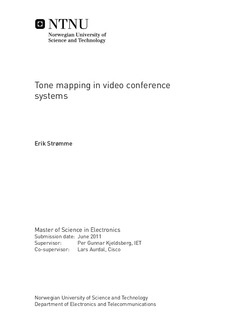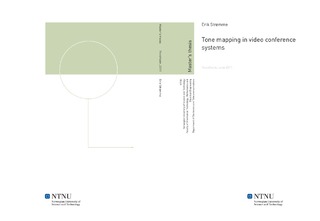| dc.contributor.advisor | Kjeldsberg, Per Gunnar | nb_NO |
| dc.contributor.advisor | Aurdal, Lars | |
| dc.contributor.author | Strømme, Erik | nb_NO |
| dc.date.accessioned | 2014-12-19T13:49:37Z | |
| dc.date.accessioned | 2015-12-22T11:50:12Z | |
| dc.date.available | 2014-12-19T13:49:37Z | |
| dc.date.available | 2015-12-22T11:50:12Z | |
| dc.date.created | 2014-06-25 | nb_NO |
| dc.date.issued | 2011 | nb_NO |
| dc.identifier | 729411 | nb_NO |
| dc.identifier | ntnudaim:6255 | |
| dc.identifier.uri | http://hdl.handle.net/11250/2370981 | |
| dc.description.abstract | Normal sensors are able to only capture a limited dynamic range. In scenes with large dynamic range, such as situations with both dark indoor and bright outdoor parts, the image will get either over- or under exposed if the exposure is not perfect. Producing high dynamic range (HDR) images will capture the full dynamic range of the scene. There are two main ways of producing HDR images. One combines multiple exposures with a low dynamic range (LDR) sensor. Another is to use a sensors which are able to capture a higher dynamic range, so called wide dynamic range sensors.Multiple exposures with a single low dynamic range sensor, is not suitable for real time video because this technique have large problems with movement. Wide dynamic range sensors only require one exposure, but these have difficulties in normal situations were LDR sensors are sufficient. A type of algorithms called tone mapping are used to reduce the high dynamic range image to at the limitations of normal monitors. Simulations show that using these algorithms on low dynamic range images will change the illumination of the scene, solving the problem. Tone mapping algorithms presented in the literature are software algorithms. Two groups of algorithms exist; local and global tone mappers. Local algorithms are time consuming, and require large amounts of memory. They are not suitable for real time implementations since they rely on filtering operations for each pixel. Global algorithms, does not rely on filtering and are less time consuming. A precomputed curve is used to map the pixels to new values. This makes the global algorithms more suitable for video. A reduced tone mapping system is presented. This reduction results in a segmented curve, which drastically reduces the memory required for defining the curve. It also makes it feasible to control temporal changes. The reduced system has been successfully implemented, achieving sufficient frequencies to be part of a real time system. | nb_NO |
| dc.language | eng | nb_NO |
| dc.publisher | Institutt for elektronikk og telekommunikasjon | nb_NO |
| dc.title | Tone mapping in video conference systems | nb_NO |
| dc.type | Master thesis | nb_NO |
| dc.source.pagenumber | 140 | nb_NO |
| dc.contributor.department | Norges teknisk-naturvitenskapelige universitet, Fakultet for informasjonsteknologi, matematikk og elektroteknikk, Institutt for elektronikk og telekommunikasjon | nb_NO |

